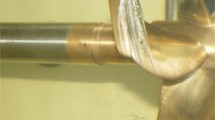Abstract
When an oceanographic vessel is sailing, the currents near the surface of ship hull are rapid, making it hard to meet the environmental requirements of scientific observation equipment. To guarantee the installation space and environmental requirements of the observation equipment, the drop keel system was proposed for the first time for ocean-graphic ships at China, to avoid the traditional “rudder-shaft” type fin keel’s disadvantage. The research study will examine the operational mechanism and functions of the drop keel system, the operating conditions of the fin keel to determine the driver method and its arrangement, and the locking method of the fin keel underwater. The research will also provide some general designs for analyzing the best plan for the drop keel system.
Similar content being viewed by others
References
An XF (2008). Research on innovation design method of mechanical product based on TRIZ. Master’s thesis, Tianjin University, 3–5. (in Chinese)
CCS (2007). Rules for lifting appliance of ships and offshore installations. 22–23. (in Chinese)
CCS (2009). Rules for classification of sea-going steel ships(Part 1). 6–7. (in Chinese)
Chinabgao (2009). Forecast study of deep research and investment for Chinese ocean-graphic vessels from 2010 to 2015. [2010.7.20]. http://www.chinabgao.com/reports/108700.html.
Chu TA (2005). Bolt tightening methods and preload control. Process Equipment & Piping, 42(3), 8–10. (in Chinese)
Cone CD (2009). ST-369 — RV “G. O. Sars” (2003). [2010.7.20]. http://www.skipsteknisk.no/default.asp?menu=35&product=20.
Huang BL, Song XH (2003). Analysing hydraulic cylinder systems on lifter frameworks. Coal Mine Machinery, 6, 36–38. (in Chinese)
Mei QS (1981). Marine rudder. China Communications Press, Beijing, 60–80. (in Chinese)
Su JL, Wang PX (1995). Two proposals on improving our marine scientific research. Bulletin of the Chinese Academy of Science, 10(1), 62–63.
Wang LW, Zhou RP, Gao H (2010). Study on the structure design and calculation of large marine stern roll. Ship Engineering, 32(5),10–14. (In Chinese)
Wu JP, Hu Y, Chen SH (2007). Numerical calculation of the hydrodynamic force on rudder. The 5th International Workshop on Ship Hydrodynamics, Zhenjiang, China, 92–96.
Wu YD (2002). Static hydraulic transmission device. Hydraulics Pnenmatics & Seals, 4, 46–48. (in Chinese)
Yanagizawa M, Kikuchi K (1982). Finite element calculations for aerodynamic coefficients of 3-dimensional body in subsonic flow using Green’s function method. Technical Report of Japan National Aerospace Laboratory, 3–22.
Zhang XM, Li YJ (2002). Study on principle of marine flexble fish-like mechanism and hydrodynamic experiment of single fin. The Ocean Engineering, 20(1), 84–90. (In Chinese)
Zhu XG (2005). Research and development of 45 ton hydrostatic winch. Master’s thesis, Tianjin University, 45–60.
Author information
Authors and Affiliations
Corresponding author
Additional information
Liangwu Wang was born in 1985. He received a B.S. degree in major of Thermal Energy and Power Engineering from Wuhan University of Technology (WHUT). And he is a M.S. degree candidate in Marine Engineering in WHUT. His research interests include the analysis of the efficiency and reliability of marine power equipment, testing and analysis of vibration and noise, structure design and calculation.
Ruiping Zhou was born in 1964. He is a professor and Ph.D advisor of marine engineering. He finished his B.S., M.S. and Ph.D in WHUT respectively. He has been working in the School of Power and Engineering of WHUT since receiving his bachelor’s degree. His main research fields: shipping CAD, analysis of the efficiency and reliability of marine power equipment, research of vibration and noise, especially on propulsion shafting alignment and vibration calculation. He has published more than 40 papers.
Xiang Xu was born in 1981, He received a B.S. and M.S. in major of Thermal Energy and Power Engineering from Wuhan University of Technology (WHUT). And he is a PhD. candidate in Marine Engineering in WHUT. His research interests include the analysis of the efficiency and reliability of marine power equipment, testing and analysis of vibration and noise, structure design and calculation.
Hong Gao was born in 1971. He is a Senior engineer in WuChang Shipbuilding Industry Co. Ltd. He is now also working in Wu Han Wu Chuan Electro-mechanical Equipment Co., Ltd, which is a subsidiary of the former. His main research fields are the shipping as well as deck machinery design and manufacture.
Rights and permissions
About this article
Cite this article
Wang, L., Zhou, R., Xu, X. et al. Research and design of drop keel system for multi-purpose oceanographic vessel. J. Marine. Sci. Appl. 11, 486–492 (2012). https://doi.org/10.1007/s11804-012-1159-5
Received:
Published:
Issue Date:
DOI: https://doi.org/10.1007/s11804-012-1159-5




